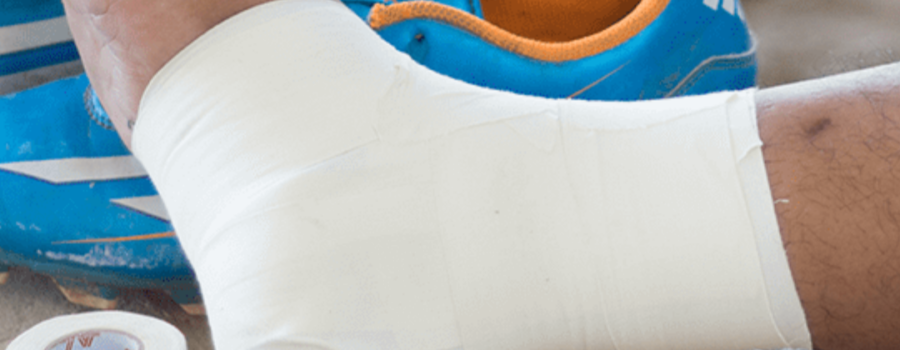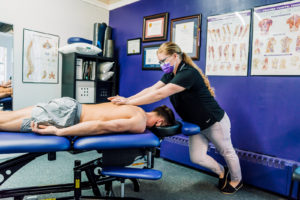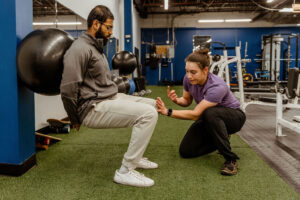
Types of taping:
There are many different types of tape that athletes use. In this blog we are focusing on athletic taping — the type that is applied for use during sport to support an injury to a muscle or joint. In another blog post we will cover the use of stretchy kinesiology tape.
The dangers of over taping:
While we all know that many athletes need taping to be able to practice their sport correctly, are we getting dangerously close to over-taping?
Over the years, I have had the pleasure of providing Athletic Therapy services to many tournaments and events for athletes of all levels in many different sports. Most of the time, I am working with youth athletes who are in shape, skilled and used to the rigors of their sports. I often see a recurring problem at these events though — there are way too many kids depending on tape to feel comfortable playing their sport. It’s a worrying trend! I turn away many kids who are requesting tape mostly for one of two reasons:
1) they don’t actually need tape
2) they have an injury that is beyond the point of being safe to play — and tape couldn’t fill the need!
Review of the uses of Athletic Tape:
There are many different applications of athletic tape, but here is a brief summary of the most common uses in sport:
1) To provide protection to a contusion: In this application I will tape a foam pad or felt pad to an area (such as the hip bone, or the bursa of the knee) to protect from additional impact.
2) To limit range of motion of a joint: These applications help protect tendon and muscle injuries by preventing the structures from going into full stretch during the game. This is often applied to the groin, hip flexor, elbow, knee or shoulder with a tensor bandage or elastic tape.
3) To provide stability to a laxity in a joint: After a ligament is injured, the laxity, or amount of play, in the joint is usually increased. A very small amount of stability can be added to a ligament with tape (a brace is better), and is usually applied to ankles, knees, wrists and fingers.
One of the major ideas of taping, however, is that it is a short-term solution to a problem, or as I like to call it a Bandaid Treatment. Tape is a fantastic tool to use to help the process of return to play after an injury, however, should not be a life-long requirement to be able to participate in sport!, and can actually promote damage!
Wait … Taping can be bad for me?
YES! Taping, unless used in specific conditions following a thorough assessment can cause many problems down the road.
1) If tape is assisting in the stability of a joint, then muscles take a break and get weaker! The body likes to take the path of least resistance, so, if something else is doing the job (such as preventing ankle rolling) then the small stabilizing muscles turn off and atrophy. The body is then more prone to injury when tape is not applied.
2) Superman Syndrome: If an athlete has a taped body part, they may feel as though they are ready or able to perform athletic tasks that should be saved for later down the road. Many people depend on tape to protect them, and take un-necessary risks or return to play too early. This allows for re-injury or prolonged recovery of injuries.
3) Psychological Dependency: If an athlete wears tape for a long period of time, they may feel unable to participate in sport if the tape or therapist to apply the tape is not available. If they do participate, they may hesitate in crucial moments, and leave themselves vulnerable to injury that otherwise could have been avoided.
So what should athletes be doing instead of taping?
My rule of thumb for any athlete that I assess or tape is that if an injury persists for longer than three weeks then they likely require some rehab!
Assessment and treatment by an Athletic Therapist:
- Ensures that you have the injury that you think you have! Knee pain could be hip dysfunction in disguise, and ankle pain could be incorrect footwear or running technique.
- Assesses the deeper cause of your injury. Even injuries that had a clear mechanism of injury often have a lingering reason for the injury occurring, or more often, a reason for the injury lingering
- Manual treatment using many different techniques to help get the body functioning the way it should
- Prescription of exercises to strengthen the injured part, and the whole body, to eventually make the tape unnecessary
- Discussion of different taping and bracing options to ensure a safe return to aid-free participation in sport
So instead of just asking your AT for tape, asking your AT if you should tape!





